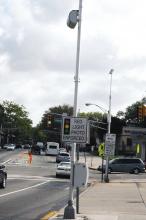Deploying speed cameras in urban areas saves vast amounts of money as well as lives, according to a two-year cost benefit analysis carried out in Barcelona, Spain
Barcelona, with an extensive urban area, is typical of many cities in the developed world. There are over 10,000 motor vehicle accidents annually with more than 12,000 people injured every year and less than 50 deaths. Economically, the cost of traffic accidents in Barcelona is over €300M a year.Among a range of initiatives in Barcelona’s Municipal Road Safety Plan was the deployment of speed cameras. In March 2003, speed camera housings and signage were deployed at 22 different sites along the city’s beltways. Only eight speed cameras were used in these housings, randomly moved from site to site. Motorists therefore never knew whether a particular site had a working speed camera.
The effectiveness of this deployment was studied over a two-year period from April 2003 to March 2005 by a team of researchers.
This earlier study proved the effectiveness of the deployment in terms of reducing the number of road traffic accidents on the beltways and consequently the number of people injured and vehicles involved in collisions, but a detailed cost-benefit analysis was undertaken by a team of researchers, primarily from Barcelona’s public health service –
The analysis
The cost-benefit analysis, using a controlled before and after study, took the figures from the earlier study into the effectiveness of the deployment. This concluded that the programme resulted in 364 fewer accidents and 507 people would have avoided injury over the two year study period. This data was derived from the local police accident database, while the Road Injury Emergency Surveillance System provided information on the distribution of the nature of injuries of people who attend an emergency department after experiencing a motor vehicle accident.Project:
Speed cameras on Barcelona’s beltways Base case:
507 people avoided injury because of speed enforcement
Costs:
€14,475,903 (Photo enforcement implementation, maintenance costs, etc.)
Benefits:
€20,506,867 (Monetised benefit of slight, moderate and severe injuries avoided)
Savings:
€831,802 (emergency, medical, hospital, property, and productivity direct costs avoided)
Net benefit:
€6,862,766In terms of costs, these included purchase and installation of the cameras amortised over the 10 year operational life of the equipment, plus maintenance and costs of moving the eight camera units around the 22 sites, police costs, and photography and ticket processing and delivery.
The net benefit was calculated as revenue from the estimated number of people who avoided injury as a consequence of the speed camera programme, subtracting costs and savings. Sensitivity analyses were performed for different scenarios – using the maximum and minimum estimated number of people who avoided injury, assuming that there was a minimum of one death avoided, using the maximum value of a statistical life, assigning all implementation costs to the first year and assuming there was no time lost due to speed reduction.
Results
The results of the analysis showed a net benefit of €6.8M in the base case scenario, which assumes no loss of life. The cost of the intervention was around €14.5M, which was offset by the €20.5M of benefits and €831,802 of savings. The biggest share of the savings was damage to property avoided and medical savings.The use of different scenarios in the sensitivity analysis suggested that the net benefit could be up to €23.1M, assuming the maximum number of injuries avoided. Sensitivity analyses suggested that net benefits could range from €5.6M to €23.1M over two years.
Overall, the study demonstrated that the use of speed cameras in urban areas has a favourable economic impact even when assessed using conservative assumptions.
Speed cameras in an urban setting:
A cost-benefit analysis
Authors: Joan Mendivil, Anna García-Altés, Katherine Pérez, and Marc Marí-Dell'Olmo - Agència de Salut Pública de Barcelona, Aurelio Tobías, IDAEA-CSIC (Institute of Environmental Assessment and Water Research-Spanish Council for Scientific Research), Barcelona(%$Linker:
For a copy of the full analysis, email Dr Anna García-Altés - Anna Garcia-Altes <%$Linker:






